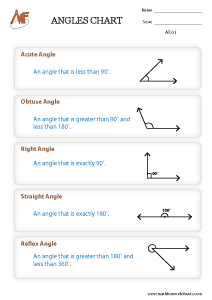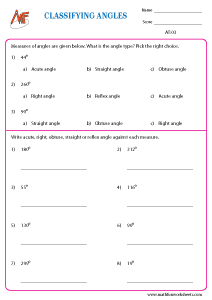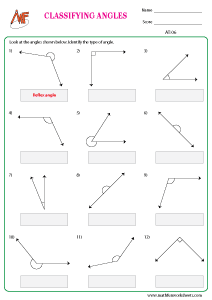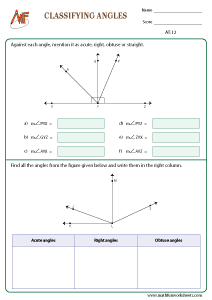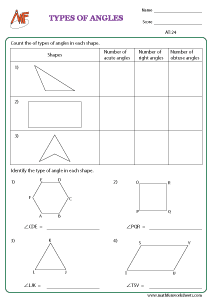Browse by Topics
- English Worksheets
- Kid's Corner
- Numbers & Operations
- Addition
- Subtraction
- Multiplication
- Division
- Decimals
- Place Value
- Roman Numerals
- Skip Counting
- Odd & Even Numbers
- Patterns
- Cardinal & Ordinal Numbers
- Rounding Numbers
- Estimation of Numbers
- Estimation of Time & Money
- Counting & Cardinality
- Comparing Numbers
- Ordering Numbers
- Fractions
- Prime & Composite Numbers
- Squares & Cubes
- Divisibility Rules
- Factors & Multiples
- Data Handling
- Algebra
- Ratio
- Proportion
- Order of Operations
- Scientific Notation
- Exponents
- Algebraic Expressions
- Evaluating Algebraic Expressions
- Simplifying Algebraic Expressions
- Graphing Lines
- Point Slope Form
- Two Point Form
- Two Intercept Form
- Equations
- Identifying Functions
- Evaluating Functions
- Function Table
- Domain and Range
- Trigonometric Charts
- Quadrants
- Polynomials
- Measurement
- Geometry
- Word Problems
Types of Angles Worksheets
Learning about the types of angles is a key part of geometry that helps you recognize and classify shapes more easily. From triangles to road signs, angles appear everywhere, and knowing how to identify them gives you a strong foundation in math.
Worksheets on classification are given in this section for Grade 5 and grade 6 students. The various types of angles are described with images on charts for easy understanding. You can print them for reference.
How do you classify angles?
Angles are simply classified according to their magnitudes. To make it easy, draw a circle. Divide it into 360 equal parts. Every single part is 1º (one degree). One complete rotation of a ray about a point is divided into 360 equal parts.
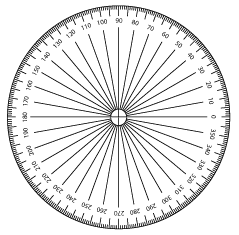
- Zero angle: Exactly measures 0º .
- Acute angle: Measures greater than 0º but less than 90º .
- Right abgle: Exactly measures 90º .
- Obtuse angle: Measures greater than 90º but less than 180º .
- Straight angle: Exactly measures 180º .
- Reflex angle: Measures greater than 180º but less than 360º .
- Full angle or Complete angle: Exactly measures 360º .
Also, refer the figures given below for clear understanding.

Types of Angles free download pdf
Classify angles(Using degrees)

Classify angles(Using degrees)
Moreover, angles can be classified based on their position. For example, adjacent angles share a common side and vertex, while complementary and supplementary angles add up to 90 and 180 degrees, respectively. These relationships help solve many geometry problems.
To reinforce your learning, try identifying angles in real life—look at scissors, ladders, or windows. Drawing and labeling each type can also boost your understanding and memory.
In conclusion, recognizing different types of angles allows you to explore geometry with confidence. By practicing regularly and using visual examples, you’ll soon master the art of angle identification and measurement with ease.

